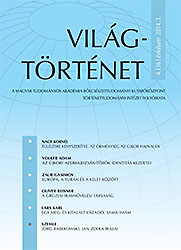Egy meg- és kitalált lázadó. Samil imám esete az Orosz Birodalommal és a Szovjetunióval, 1859–1953
(Re-)Inventing a Rebel: The Case of Imam Shamil in Tsarist Russia and in the Soviet Union, 1859–1953
Author(s): Lars KarlSubject(s): 19th Century, Pre-WW I & WW I (1900 -1919), Interwar Period (1920 - 1939), WW II and following years (1940 - 1949)
Published by: Magyar Tudományos Akadémia Bölcsészettudományi Kutatóközpont Történettudományi Intézet
Keywords: representation of ‘history’; multiethnic empire; Muslim regions; Dagestan; Chechnya
Summary/Abstract: In fact, the collapse of the utopia of a Soviet ‘family of peoples’ has turned historical research – with focus on the forming of nations in the newly founded states in Eastern Europe, the Caucasus, and Central Asia – into an extremely topical issue. The article focuses on the issue of functions and strategies of official politics of history and historiography in late Tsarist Empire and the Soviet Union. The central topic is the generation, mediatisation and representation of ‘history’ in a multiethnic empire and the use of the imperial politics of history as a political strategy of collective memory in its Muslim regions. One of the most remarkable and, in regard to its re-coding and transformation, most complex historical narratives in the non-Russian periphery is illustrated by the figure of Shamil, the third and most famous and successful imam (leader) of the Muslim resistance to the Russian occupation of the North-Eastern Caucasus. As a result of his many successes Shamil became a national hero for many Caucasian Muslims, especially in Dagestan and Chechnya. In Soviet historiography Shamil was celebrated as the hero of a national liberation struggle, his personality described in the most glowing terms, and his movement depicted as essentially ‘progressive’, although under a religious cloak. The movement against Russia and native classes was seen as an anti-feudal uprising according to classic Marxist interpretation. The Second World War brought about a major realignment in Moscow’s nationality policy. In Soviet historiography, the so-called agency theory has been dominating since the early 50s, whereby this and subsequent ‘Holy Wars’ of the mountain peoples were supposed to have been controlled by Turkish and British imperialism to weaken Tsarist Russia at its foundations. It is hardly surprising that, after the breakdown of the Soviet system, the various political forces in the North Caucasus were frequently competing against each other. Those identify the era of the Imamate as a reference point and try to derive the necessary legitimacy for their present claims from a supposed continuity
Journal: Világtörténet
- Issue Year: 2014
- Issue No: 3
- Page Range: 483-508
- Page Count: 26
- Language: Hungarian

